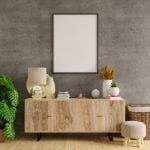What colors go together when decorating your home is a crucial question in interior design. Color plays a significant role in setting the mood and atmosphere of a space, making it essential to choose the right combinations for home decor.
Understanding the color wheel and different color schemes can help homeowners create a harmonious and visually appealing environment.
In this article, we will explore the importance of color in home decor, how to use the color wheel to your advantage, choosing the right color scheme for each room, creating contrast and balance with colors, using accent colors to add personality, understanding the psychology of color, popular color combinations for different design styles, and tips for experimenting with color in small doses.
Color has a profound impact on our emotions and can significantly influence the ambiance of a room. By understanding the psychology of color and how different colors interact with one another, homeowners can create spaces that evoke specific moods or feelings.
In addition to discussing how to effectively use different colors in home decor, this article will also provide examples of popular color combinations for various living spaces like bedrooms, living rooms, and kitchens. With these tips and insights, readers will be equipped to make informed decisions when selecting the perfect color schemes for their homes.
Understanding the Color Wheel
When it comes to decorating your home, understanding the color wheel is essential in achieving a cohesive and visually appealing look. The color wheel consists of primary colors (red, blue, yellow), secondary colors (orange, green, purple), and tertiary colors (a mix of primary and secondary colors). In addition to this, there are different color schemes that can be created using the color wheel, such as complementary, analogous, and monochromatic.
Using the color wheel as a guide can help you determine what colors go together when decorating your home. Complementary colors are located opposite each other on the color wheel and create a dynamic and vibrant look when used together. Analogous colors are located next to each other on the color wheel and provide a harmonious and soothing effect. Monochromatic color schemes involve using variations of the same hue, creating a simple yet elegant look.
Incorporating these different color schemes into each room of your home can greatly impact the overall ambiance. For example, using complementary colors in a living room can add energy and vibrancy to the space, while opting for an analogous color scheme in a bedroom can create a serene and calming atmosphere.
Whether you want to make a bold statement or create a more subtle look, understanding how to use the color wheel effectively is key when choosing the right color combinations for your home decor.
Tip: Use the Color Wheel as a Tool
- Keep a physical or digital copy of the color wheel handy for reference
- Experiment with different combinations by overlaying different hues on the color wheel
- Consider the mood you want to achieve in each room before selecting a color scheme
Choosing a Color Scheme for Each Room
When it comes to choosing a color scheme for each room in your home, the options can feel endless. However, by considering the function and atmosphere of each room, you can narrow down your choices and create a cohesive look throughout your home. One important factor to keep in mind is what colors go together when decorating your home. By understanding color combinations and their impact, you can make informed decisions when selecting the perfect palette for each space.
For bedrooms, soothing and calming colors are often preferred to create a relaxing atmosphere. Soft blues, gentle greens, or muted lavender shades are popular choices for creating a serene bedroom environment. These colors are known for promoting tranquility and restfulness, making them ideal for spaces designed for relaxation.
In contrast, living rooms are typically more social areas where warm and inviting colors can be used to encourage conversation and relaxation. Shades of warm neutrals such as beige or light gray can serve as a versatile base for a living room color scheme. These neutral tones provide a timeless backdrop that pairs well with various accent colors depending on personal preference.
Finally, kitchens are often considered the heart of the home where functionality meets style. Many people opt for brighter and more energizing colors in this space to promote productivity and energy. Vibrant yellows, lively greens, or even bold reds can add personality and character to a kitchen while maintaining an uplifting ambiance.
By carefully considering the purpose of each room in your home, you can select color combinations that not only complement one another but also enhance the overall look and feel of each space.
| Room | Ideal Color Schemes |
|---|---|
| Bedroom | Soft blues, gentle greens, muted lavenders |
| Living Room | Warm neutrals like beige or light gray |
| Kitchen | Vibrant yellows, lively greens or bold reds |
Creating Contrast and Balance With Colors
When decorating your home, it’s essential to consider how different colors work together to create contrast and balance in a room. The right combination of light and dark colors can help achieve a harmonious look that enhances the overall ambiance of the space. So, what colors go together when decorating your home? Understanding contrast and balance is key to making the most of your color choices.
To create contrast, you can pair complementary colors together. These are colors that are opposite each other on the color wheel, such as blue and orange or red and green. Using complementary colors can make each shade appear more vibrant when placed alongside one another.
On the other hand, for a more subtle approach to contrast, you can opt for analogous colors. These are hues that sit next to each other on the color wheel, like blue, green, and teal or red, orange, and yellow. Analogous color schemes create a sense of harmony and flow in a room.
In addition to creating contrast, it’s important to achieve balance with your color choices. This involves considering the visual weight of different hues within a space. Dark colors tend to have more visual weight than lighter shades, so incorporating both light and dark tones can help balance out a room.
For example, if you have dark furniture or flooring in a room, adding lighter walls or accent pieces can prevent the space from feeling too heavy. Conversely, if you have predominantly light-colored furniture or decor elements, adding darker accents can add depth and richness to the overall design.
| Popular Color Combinations | Design Style |
|---|---|
| Black and White | Modern |
| Navy Blue and Gold | Traditional |
| Coral Pink and Turquoise | Bohemian |
Using Accent Colors to Add Personality
When it comes to decorating your home, choosing the right color scheme is essential for creating a cohesive and inviting space. But beyond the main palette of colors, accent colors play a crucial role in adding personality and visual interest to a room. Accent colors are the small pops of color that can be incorporated through accessories, furniture, and artwork, and they can truly elevate the overall look of a space.
Here are some key ways in which you can effectively use accent colors to add personality to your home decor:
- Emphasize key focal points: Use accent colors to draw attention to specific areas or features in a room, such as a statement wall, a piece of artwork, or even architectural details like crown molding.
- Balance with neutral tones: Pairing bold accent colors with neutral tones like white, gray, or beige can create a visually appealing contrast and prevent the space from feeling too overwhelming.
- Inject vibrancy: Bright and vibrant accent colors can inject energy and liveliness into a room, making it feel more dynamic and inviting.
In addition to these practical tips for using accent colors, it’s also important to consider the psychology of color when incorporating these pops of hues into your home decor. Certain shades can evoke specific emotions and moods, so understanding how different accent colors may impact the ambiance of a room is crucial.
Overall, when used thoughtfully and in coordination with the main color scheme, accent colors have the power to infuse your home with personality and charm. Whether you prefer subtle hints of color or bold statements, incorporating accent colors is an effective way to add depth and character to your living spaces.
The Psychology of Color
Impact of Color on Mood and Behavior
Research has shown that certain colors can have a direct impact on people’s moods and behaviors. For example, warm tones like red, orange, and yellow are known to create a sense of energy and excitement, making them ideal for spaces where social interaction or productivity is desired. On the other hand, cool tones such as blue and green are often associated with relaxation and tranquility, making them suitable for bedrooms or areas designated for unwinding.
Creating the Desired Ambiance
When it comes to home decor, it’s important to consider the desired ambiance of each room before selecting color combinations. For instance, vibrant and bold colors may be suitable for areas where creativity and stimulation are encouraged, while softer pastel hues may be more fitting for spaces intended for relaxation or meditation. By taking into account the psychological effects of different colors, homeowners can create an environment that aligns with their preferences and lifestyle.
It’s also worth noting that individual reactions to colors can vary based on personal experiences and cultural influences. Therefore, when choosing color combinations for home decor, it’s essential to consider not only the psychological effects of color but also personal preferences and the overall aesthetic vision for each room in the home.
Popular Color Combinations for Different Design Styles
When it comes to decorating your home, the color scheme you choose can make a significant impact on the overall look and feel of each room. Different design styles call for different color combinations in order to achieve a cohesive and harmonious aesthetic. Whether you prefer a traditional, modern, bohemian, or any other design style, there are popular color combinations that work well for each.
Traditional Design
In traditional interior design, classic and timeless color combinations are often used to create a sense of elegance and refinement. Warm neutrals such as beige, ivory, and taupe are commonly paired with rich, deep hues like burgundy, navy blue, or forest green. These complementary colors add depth and sophistication to traditional interiors while providing a cozy and inviting atmosphere.
Modern Design
For modern interior design styles, minimalist color palettes with clean lines and bold contrasts are popular choices. Black and white is a classic modern color combination that exudes simplicity and sophistication. In addition to this timeless duo, modern design also embraces the use of neutral tones like gray or tan paired with pops of vibrant accent colors such as red or electric blue to create visual interest.
Bohemian Design
Bohemian interior design is all about expressing individuality and embracing unique color combinations. This style often incorporates rich jewel tones like deep purple, emerald green, and sapphire blue along with earthy hues such as terracotta, mustard yellow, and burnt orange. These vibrant colors come together to create an eclectic and free-spirited vibe that is characteristic of bohemian interiors.
No matter what your preferred design style may be, it’s important to consider how different color combinations can enhance the overall aesthetic of your home. By understanding popular color combinations for different design styles, you can effectively bring out the essence of each style while creating a space that truly reflects your personality and taste.
Tips for Experimenting With Color in Small Doses
When it comes to decorating your home, experimenting with color can be both exciting and daunting. If you’re hesitant about committing to a bold or unconventional color combination, incorporating it in small doses is the perfect way to test the waters. Whether you want to add a pop of color to a neutral room or introduce a new color scheme without overwhelming the space, there are plenty of ways to experiment with color in small doses.
One way to incorporate bold colors in small doses is through accessories such as throw pillows, rugs, and curtains. By adding these colorful accents to a room, you can instantly breathe new life into the space without making a long-term commitment.
Another option is to incorporate colorful artwork or decorative pieces that serve as focal points within the room. This allows you to experiment with vibrant colors while maintaining flexibility in case you want to switch things up in the future.
Additionally, consider using paint or wallpaper on an accent wall to introduce a bold color into a room without overpowering the entire space. Whether it’s a vibrant shade or a trendy pattern, an accent wall can become a focal point that adds visual interest and personality to the room.
Lastly, incorporating colorful furniture or statement pieces can also be an effective way to experiment with color in small doses. Whether it’s a brightly colored chair or a unique piece of furniture, these items can serve as conversation starters and add character to your home decor.
Experimenting with color in small doses allows you to infuse your home with personality and vibrancy while still maintaining balance and harmony within the space. By incorporating bold colors through accessories, artwork, accent walls, or furniture, you can play around with different color combinations and embrace the power of color in your home decor without feeling overwhelmed by the commitment.
Conclusion
In conclusion, the impact of color on the atmosphere and mood of a home cannot be overstated. From the calming effect of cool blues to the energizing power of warm reds, the right color combinations can truly transform a space. Understanding the basics of the color wheel, as well as different color schemes such as complementary and analogous, is essential in creating a harmonious and balanced home decor.
When selecting color schemes for each room, it’s important to consider the function and ambiance you want to achieve. For example, serene and relaxing colors like soft greens and pastel blues are ideal for bedrooms, while vibrant and lively colors such as yellows and oranges work well in a kitchen or dining area. Understanding color psychology can also guide your choices towards creating the desired ambiance in each room.
Finally, embracing accent colors as well as popular color combinations for different design styles can add character and charm to your home decor. Whether you prefer traditional or modern design, there are endless possibilities when it comes to experimenting with color in small doses.
Ultimately, decorating your home with careful consideration of colors can create a space that not only looks beautiful but also feels inviting and harmonious. So go ahead, have fun experimenting with what colors go together when decorating your home.
Frequently Asked Questions
How Do I Choose a Color Combination for My House?
When choosing a color combination for your house, consider the mood or atmosphere you want to create in each room. Think about coordinating colors based on furniture, decor, and natural light. It’s also essential to consider how different colors will flow from one room to another.
What Are the 3 Best Colors That Go Together?
The best colors that go together often depend on personal preferences and the specific purpose of the space. However, some classic combinations include blue and white for a calming effect, grey and yellow for a modern look, and green and brown for a natural, earthy feel.
These combinations are versatile and can be adapted to different styles and rooms in your house.
How Do You Match Colors in House Decorating?
Matching colors in house decorating involves understanding color theory – how different hues complement or contrast each other. You can coordinate colors by using a color wheel as a guide to find complementary, analogous, or monochromatic color schemes. Additionally, take into account the existing elements in your space such as furniture, textiles, and lighting when selecting coordinating colors.

I’m thrilled to be your companion on this exciting journey through the world of home decor and design. With a passion for turning houses into homes and a keen eye for the finer details, I’m here to help you transform your living spaces into beautiful, functional, and meaningful havens.





